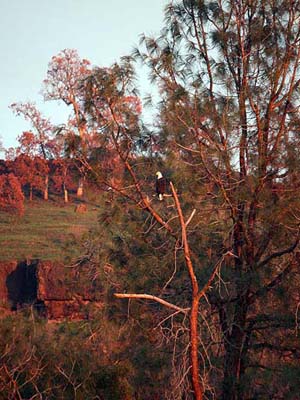
EAGLE CREEK RANCH
CHICO, CALIFORNIA
This 7,400-acre collection of former cattle ranches along Highway 99 in Butte County is a scenic and historical property. We have pretty much eliminated all grazing to decrease soil erosion and silting, and to support native grasses and oak regeneration. We’ve planted oak trees to strengthen and restore the riparian habitat. The Ranch is a significant roosting site for forty-plus Bald.
Before being homesteaded in the 1800s, this ranch was the winter residence for Maidu Indians. There are hundreds of Maidu caves. Few artifacts remain, most having been taken to the Chico State Museum. Wagon routes, home sites and hand-dug wells have been preserved and the ruts from the wagon wheels can still be seen on some of the old roads.
We have planted some 4,000 valley and blue oak, and other trees over the years. Most died, some survived. Natural oak regeneration has been a subject of considerable study and concern for us here. Oaks don’t typically regenerate (naturally generate young replacement trees) much in the Sierra foothills but after we removed the cattle and with the late Spring rains of 2007, we saw the first resurgence of oaks in about four decades with six-inch growth over some areas of the Ranch. Unfortunately these young oaks were wiped out with the Cohasset fire in 2008. We also lost a lot of wildlife cover and many of the big, mature oaks.Firefighting efforts in recent years have focused away from quick response ground crews for wildfires and moved towards protection of homes. Fire can often be controlled with swift response and nothing more than bulldozers, backpacks and McClouds if caught early enough. Like the unintended consequences of so many other well-intended regulations, rules prohibiting or limiting burning in the winter when fire won’t hurt big trees increase the probability of catastrophic fires in the summers.
Eagle Creek is the site of the Veiny Monardella, thought to be extinct when it was discovered recently in a botanical survey in connection with the Town of Paradise plan to use a portion of the upper Ranch for a waste treatment site which would have converted waste water to tertiary treated water, valuable for land that has precious little summer water. Eagle Creek sits on a large underground aquifer area referred to as the Lower Tuscan, and is a recharge zone for the aquifer.
The Ranch has a lot of evidence of Indian activity, including water basins carved out of lava which are filled by springs.We are presently removing trees which were killed but not burned and piling them away from live trees. This provides cover for wildlife and improves the chances of living trees to survive the next fire. Valley and foothill riparian, Blue Oak, Chaparral and grassland habitat provide foraging habitat and nesting, roosting, shelter and escape cover for more than one hundred bird species and fifty-plus species of mammals. Notable among these are: bald and golden eagles, black shouldered kite (very rare), coopers hawks, osprey, kestrels, burrowing owls, and loggerhead shrike. Much damage has been done to the thin layers of soil on the Ranch by cattle over the past 150 or so years, since grazing was introduced. In some areas, 4-6 inches of soil have moved off the hillsides and down into the creeks during heaving rain.
Rebuilding soil is a long process but it can be done. We will continue to plant trees, protect natural growing trees, and encourage brush for browsing and native grass restoration, all of which helps to build soil. We need both soil depth and the humus or top layer produced by organic decomposition of leaves and grasses.
Over the years, many fire trails were pushed across the property, probably to stop fires. These left miles of dirt berms alongside dozer-built corridors of exposed lava cap. We are spreading these berms back to natural and using some of the old “Cat” trails to make good access for plantings and fire protection.

Bald eagle on our ranch
HISTORY
A valley two miles towards the heart of the Ranch was the site of Jim and Tammy Baker’s revival attended by 1,200 in the early ‘80s.
-
Eagel Creek Ranch
eaglecreekranch/photos/001.jpg -
Lake Merritt
eaglecreekranch/photos/002.jpg
-
Kathi
eaglecreekranch/photos/003.jpgNear Indian Bathtub
-
Eagle Creek Ranch
eaglecreekranch/photos/004.jpg
-
Cattle
eaglecreekranch/photos/005.jpg -
Melissa and Jane Winnaman
eaglecreekranch/photos/006.jpgCattle reduction has allowed grass to grow

-
Hamlin Creek
eaglecreekranch/photos/007.jpg
-
Eagle Creek Ranch
eaglecreekranch/photos/008.jpg -
Wood Duck Nest
eaglecreekranch/photos/009.jpg -
Deer
eaglecreekranch/photos/010.jpgWe don't allow hunting so wildlife can live peacefully.
-
Eagle Creek Ranch
eaglecreekranch/photos/011.jpg -
Eagle Creek Ranch
eaglecreekranch/photos/012.jpg -
Tami and Jimmy Bakker
eaglecreekranch/photos/013.jpgHeld their revival here
-
Felix
eaglecreekranch/photos/014.jpgTrimming trees to protect against fire from reduced grazing.

-
Big Barn
eaglecreekranch/photos/g.jpgAt Eagle Creek Ranch.

-
Eagle creek
eaglecreekranch/photos/h.jpg"The Little Grand Canyon"

-
Owen and Theresa
eaglecreekranch/photos/i.jpgAt Eagle Creek

Owen and Theresa
eaglecreekranch/photos/f.jpgAt Eagle Creek Canyon

© 2009 Preservation Partners